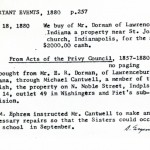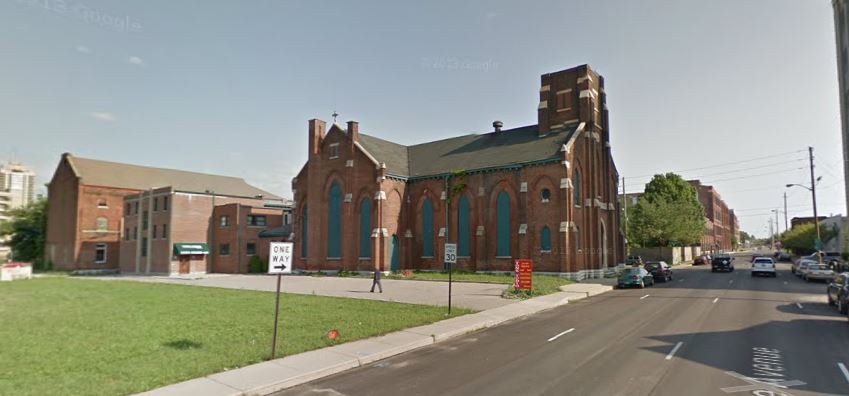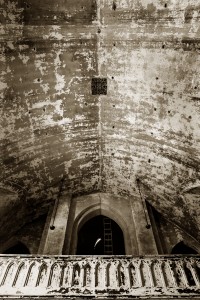You may have driven up College Avenue, just north of the “gentrified” area of Lockerbie Square. This area was once a working class neighborhood filled mostly with Irish immigrants who came to the United States and Indianapolis in the mid 1800’s.
Originally, most Catholics attended the mother church in Indianapolis, Saint John the Evangelist. In 1857 Saint Mary’s was formed for the Germans. Saint Patrick’s, which was founded as St. Peter’s was further south.
There was a need for a local parish on what we now call the near eastside. Herman Alerding, in his work; History of the Catholic Church in the Diocese of Vincennes wrote:
My interest in the church is personal. My Grandmother was baptized there and my Great-Great Grandfather was one of the founding members of the parish. There’s a lot of unknowns about him. His name was Michael Cantwell. He arrived in Indianapolis from Clonmel, County Tipperary, in the summer of 1848. Michael was a Millwright, but we don’t know how much that occupation figured into the building of the church that still stands on that corner of College and North.St. Joseph’s congregation was organized in 1873 by the Rev. Joseph Petit. He erected a two-story building on East Vermont street, which was to be church, school and parsonage. He resigned his charge in April, 1874. The congregation was then attended from St. John’s by Rev. E. J. Spelman and Rev. Francis M. Mousset. In 1874 Bishop de St. Palais built a roomy, three-story addition to the building erected by Father Petit, and made of it St. Joseph’s Seminary. The congregation continued to have regular services in the seminary chapel. The Rev. H. Alerding was appointed to a position of procurator for the seminary and pastor for the congregation in the fall of 1874, when the seminary was opened. The seminary continued for one year and was then abandoned. From that time until the spring of 1879 nothing was done by way of improving the condition of the congregation, because Bishop de St. Palais’ consent to build a church was persistently withheld. In the month of April, 1879, BishopChatard determined to make of the seminary a hospital. He not only urged the congregation to build a new church in some other quarter, but refunded $2,000 of the money spent on the old building. Two lots, on which St. Joseph’s Church now stands, on the corner of North and Noble streets, were purchased for $5,500 on April 25, 1879. The corner-stone was laid on July 20, 1879, by Bishop Chatard, assisted by the priests of the city. On July 4, 1880, the new church was blessed by Bishop Chatard and the first mass celebrated by Father Petit, of Madison. St. Joseph’s Church is a Gothic structure. It is 130 feet long. – the nave 45 feet, and the transept 70 feet in width, the height of spire 135 feet. The cost of the church was $17,000.” Churches of similar designs built in 1882 have cost $25,000. In 1881 a parsonage was erected at a cost of $2,500. In 1882 three new altars were built for $ 1 ,200. In 1883 a new pulpit for $300, etc. The school existed in St. Joseph’s from the time the present pastor received charge of the congregation. It was taught by Mr. P. Jennings for one year, in 1875 to 1876; by the Misses O’Connell in 1876 to 1877 ;” and since then by the Sisters of Providence. This community bought a lot south of the church in 1880; the buildings on it have since been utilized for school purposes, but they prove to be inadequate. The prospects are that a new building will be erected in the near future. The congregation numbers about 225 families.
The cornerstone for the present structure was laid in 1879. A parade was held and Bishop Francis Chatard preached at the ceremony. The Indianapolis Journal published a lengthy article on the ceremony. The article suggested that the church would be done by the Spring of 1880. Also interesting to note at the end of the article they mentioned that items were placed in the cornerstone. To my knowledge the cornerstone is intact and the items are still inside.
It is difficult to picture the way that the church and the neighborhood looked over 125 years ago. There are virtually no pictures available. The picture above is from the Indiana Historical Society. As I already mentioned, this was a working class neighborhood and you can see that in the picture.  Notice the large structure next to the church. This was St. Joseph’s school, run by the Sisters of Providence of St. Mary of the Woods. The school opened in the Fall of 1880. The building was already there, its use, previous to becoming St. Joseph School, is unknown. The Sisters purchased it for $2000 in February of 1880.
Notice the large structure next to the church. This was St. Joseph’s school, run by the Sisters of Providence of St. Mary of the Woods. The school opened in the Fall of 1880. The building was already there, its use, previous to becoming St. Joseph School, is unknown. The Sisters purchased it for $2000 in February of 1880.
Today, however, the church stands empty. In 1949 Archbishop Schulte made the decision to suppress the parish. The area was becoming less residential and more industrial.  The parish rectory became the “Catholic Social Services” agency office of the archdiocese. The old school was torn down and the steeple on the church was removed. Here are some less than clear clippings, photocopied many times over that show this activity.
The parish rectory became the “Catholic Social Services” agency office of the archdiocese. The old school was torn down and the steeple on the church was removed. Here are some less than clear clippings, photocopied many times over that show this activity.
As I already mentioned, the old rectory became the office for Catholic Social Services. The church building became a hall, used for Catholic Social Services activities. In the late 1970’s it looked like this:
The buildings around it — in fact, the entire west side of College Avenue, became vacant and the church building stands alone now.
The last photos are a remarkable set created by a local Indianapolis photographer named M.W. Lafary. In November of 2011 he published some pictures of the inside of the church. Lafary is known for his use of film (versus digital) photography. The photographs that he took of the inside of Saint Joseph present a somewhat depressing view. One tries to imagine a bright and open church decorated with the frescoes of Giovanni Gioscio a famous fresco artist from Italy. A church filled with children from the school next door. Instead we find an empty dark place now used for storage. One can only imagine what it was like in 1885 when my Great-Great Grandfather was buried from the Church, or 1890 when my Grandmother was baptized.








My Grandfather was baptized in St. Joseph’s church in 1898. Michael Cantwell was my Great Grandfather. My mother was Elyse Marie Cantwell.